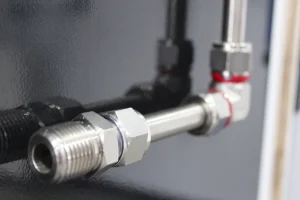Industrial piping demands connections that install quickly and perform reliably under pressure, temperature swings, and constant vibration. Grip ring technology answers that demand with mechanical compression, creating a robust seal without crimping tools, solvents, or heat. By relying on geometry and materials science rather than sealants, these fittings offer predictable results in aluminum piping and other common media lines. If you’re comparing options or building a standard, remember to View Details in the manufacturer’s datasheet to confirm pressure ratings and media compatibility. This guide explains how grip rings form airtight and reusable joints, why the approach speeds projects, and how the design resists vibration, corrosion, and misalignment across various pipe sizes and materials.
How Grip Rings Use Compression to Form Airtight Seals
The core of the design is mechanical compression: a hardened ring with angled teeth grips the pipe exterior while a sealing element—typically an elastomeric O‑ring—forms a tight, airtight seal at the interface. When the nut or collet is tightened (or in push-fit models, when the pipe is fully seated), axial force is converted into radial pressure on the pipe. That pressure does two things at once: it drives the grip ring teeth to bite microscopically into the pipe wall and compresses the seal to close micro-voids. Because the sealing force is produced by the assembly’s geometry, the joint is repeatable and does not rely on thread sealants or curing adhesives. The result is consistent sealing performance on aluminum tubing and other compatible pipe materials, even after thermal cycling.
The mechanics of the grip and seal
Inside the body, a conical seat drives the ring inward as the pipe is inserted, and this wedge action multiplies clamping force without over-compressing the O‑ring. The grip ring teeth are designed to maximize contact area while avoiding deep penetration that could thin the pipe wall. Meanwhile, the seal is supported by a backup surface that prevents extrusion under high pressure, helping the fitting maintain low leak rates across temperature changes. In quality designs, load paths are balanced so the pipe remains centered, which reduces eccentric stress and preserves the seal profile. This synergy explains why many engineers specify Grip Ring Fittings when they need a reliable, tool-free connection that behaves like a precision mechanical joint rather than a temporary coupling.
Tool-Free Installation That Speeds Up Piping Projects
On busy job sites, tool-free installation can save hours across a single run, especially for overhead lines and dense equipment clusters. Grip ring assemblies are engineered so that proper insertion depth and axial force produce both the grip and the seal, which eliminates the need for crimp heads, heat fusion equipment, or thread compound cleanup. The result is faster cycle times and fewer variables that can lead to rework, particularly in compressed air and vacuum systems. Because the sealing mechanism is mechanical, installers can achieve consistent results in tight spaces where wrenches and torque verification are impractical. This approach also shortens commissioning, with quick pressure tests that confirm airtight performance.
Step-by-step insertion and lock
A simple, repeatable method helps ensure performance. First, cut the pipe square and deburr both the outer and inner edges so the O‑ring isn’t nicked during insertion. Next, mark the manufacturer’s recommended insertion depth; this visual cue confirms that the tube is fully seated and the grip ring has engaged. Then, push the pipe into the fitting with a firm, even motion until it bottoms out; the internal geometry will lock the ring and compress the seal simultaneously. Finally, perform a quick pull test to verify engagement before pressurizing the line—this small step minimizes leaks and prevents blow-offs at startup.
Vibration-Resistant Designs for High-Demand Environments
Industrial facilities are full of vibration sources—compressors, motor drives, machine tools, and conveyors all generate cyclic loads that can loosen subpar connections. Grip ring designs address this by using serrated teeth and tapered collets that maintain clamping force even as the pipe experiences micro-movements. As vibration attempts to shift the pipe, the ring’s geometry converts motion into additional radial load, keeping the connection tight and the seal compressed. Paired with an O‑ring that has the right durometer and compression set resistance, the assembly retains an airtight seal over long duty cycles. This stability is vital for compressed air and nitrogen lines where small leaks compound into significant energy losses.
Design features that resist loosening
A few engineering details make the difference in high-vibration zones. Multi-tooth rings distribute clamping force around the circumference, preventing localized deformation that could trigger creep or backing out over time. Controlled surface hardness on the grip ring helps the teeth bite consistently into aluminum or semi-rigid plastic without scoring the material. Collet taper angles are optimized to resist outward relaxation; when the line shakes, the taper continues to convert axial motion into radial grip rather than allowing slippage. Finally, seals with anti-extrusion backing resist “pumping” under vibration, so the interface remains gas-tight even near compressors and robotics. When selecting SKUs, don’t hesitate to View Details in testing certifications or vibration endurance data, as these specs reveal real-world durability beyond simple pressure ratings.
Corrosion-Resistant Construction for Long-Term Durability
Corrosion is a silent failure mode that raises maintenance costs and risks unplanned downtime. High-quality assemblies counter this with corrosion-resistant bodies—often anodized aluminum or plated brass—combined with stainless steel grip rings and carefully selected elastomers. The anodized layer on aluminum provides a hard, inert surface that reduces oxidation, while nickel or chrome plating on brass enhances resistance to moisture and oils commonly found in compressed air. Stainless steel grip components retain spring force and surface integrity even in humid or mildly caustic environments, keeping the clamping action stable over time. When metal choices align with the media and ambient conditions, fittings maintain their seal and structural reliability for years.
Choosing materials for your environment
Material selection should reflect the full exposure profile: gas composition, humidity, washdown chemicals, salt fog, and temperature. For general plant air, anodized aluminum bodies with stainless rings and NBR or EPDM seals offer an excellent balance of durability and cost. In food, pharma, or coastal facilities, stainless steel bodies may be preferred for maximum chemical resistance and cleanability. If oils or hydrocarbons are present, consider FKM seals to prevent swelling and maintain low compression set. Many suppliers provide variant codes and corrosion test data; matching these properly is one reason specifiers consistently return to Grip Ring Fittings for demanding installations that must stay leak-free without constant upkeep.
Compatibility With Multiple Pipe Sizes and Materials
A major advantage of this technology is broad compatibility across pipe sizes and materials, enabling efficient system upgrades and expansions. The grip mechanism engages the outside diameter, so as long as the OD and wall thickness fall within the specified range, the fitting clamps securely and the seal seats correctly. This works well with rigid aluminum piping, semi-rigid plastics like nylon and PE, and even copper in certain models. Careful tolerancing allows the teeth to account for minor OD variations while the O‑ring provides conformal sealing, creating a balanced joint. For mixed-material systems, transition fittings help maintain performance without complex adapters or reducers.
Sizing guidance and transition tips
Correct sizing starts by verifying the OD standard—metric or imperial—and matching it to the fitting’s nominal size, not the pipe’s ID. Insertion depth marks are essential on larger diameters to ensure the grip ring and seal are fully engaged; shallow insertion is a common cause of startup leaks. For plastics, confirm allowable wall thickness ranges and temperature derating so the grip isn’t overly aggressive; for soft metals like copper, look for rings specifically designed to prevent over-bite. When connecting aluminum mains to flexible drops, use straight connectors or elbows rated for both substrates to preserve flow while maintaining the seal. This versatility is one reason engineers choose Grip Ring Fittings to simplify inventory and standardize across multi-material systems without compromising reliability.
Supporting Maintenance-Free Operation in Air Systems
Compressed air systems lose efficiency quickly when small leaks accumulate, and manual retightening isn’t a sustainable strategy. By combining a mechanical grip that resists movement with a resilient seal that maintains compression, these fittings support essentially maintenance-free connections. Their geometry counteracts vibration and pressure pulsation, while corrosion-resistant materials preserve clamping force and sealing surfaces. In practice, this means fewer callbacks after commissioning, stable pressure at point of use, and lower compressor run time. Over the life of the system, the energy savings from reduced leakage often exceeds the premium paid for better fittings.
Practices that extend service life
Even robust fittings perform best with a few simple practices. Keep tubing cuts square and burr-free to protect the O‑ring, and avoid bending the pipe within the stated minimum radius near the connection so the ring isn’t pried outward. Maintain clean, dry air with filtration and dryers appropriate to your climate; moisture and particulate shorten seal life and can corrode mating surfaces. Schedule periodic visual inspections for abrasion and mechanical interference, reserving pressure tests for system changes rather than routine “tightening.” If you are building a spec sheet or evaluating alternatives, View Details in the manufacturer’s technical library for insertion depths, allowable media, and derating curves—this information helps lock in a low-leak, low-maintenance standard across your facility.






More Stories
Comprehensive Overview of Fire Alarm Installation for Businesses
Why SEO Experts Advise Against Buying Reviews
BTCC.COM: Navigating the World of Leveraged Crypto Investments